From undrafted free agent to one of the most prolific passers in NFL history, Jim Hart’s career had more than its fair share of challenges. The Chicago area native had to overcome fan favorite Charley Johnson in the late 60s, the Bob Hollway era in the early 70s, a career-threatening shoulder injury in 1973, and #1 draft pick Steve Pisarkiewicz in 1979. But he could not beat his last challenger, Father Time, which is still undefeated.
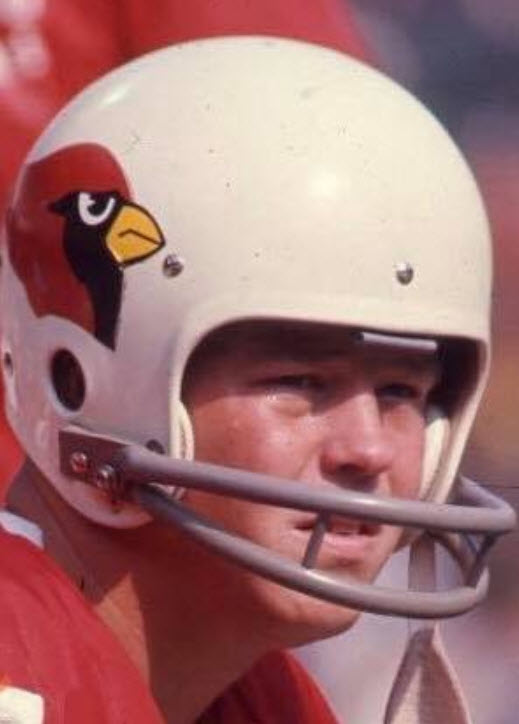
After losing his starting job to Neil Lomax, the Big Red released the 39 year old Hart in 1984. He would retire a year later as the team’s all-time leading passer, throwing for 34,665 yards and 209 TD passes. Only Johnny Unitas and Fran Tarkenton had thrown for more yards than Hart.
EARLY LIFE
James Warren Hart was born in Evanston, IL on April 29, 1944. His father George passed away when Jim was only seven years old. His mother, Marge, later married Fred Gilbert whose love of sports rubbed off on Jim.
As a youngster, Hart excelled at baseball. He once struck out 19 batters in seven inning game in 1958.
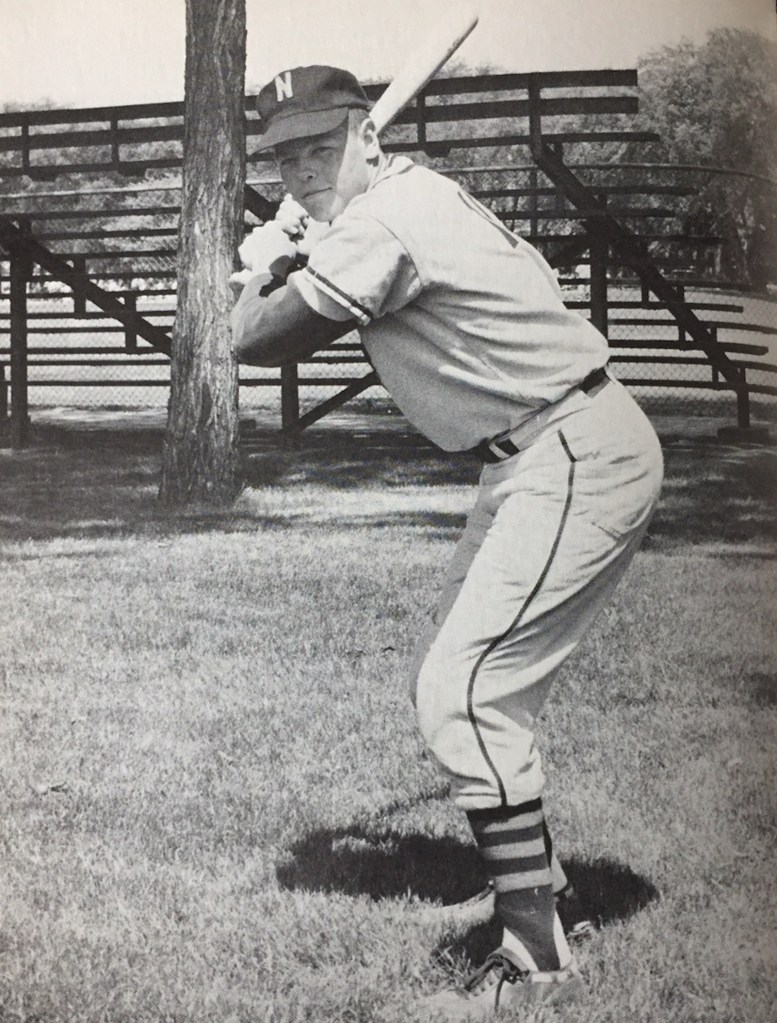
He would star in baseball, basketball, and football at Niles West High School, earning all-conference honors in all three sports his senior year. He led the Indians (now the Wolves) to a conference title when he forced a late fumble, threw the game tying TD pass with 20 seconds left, and rushed for the game winning two point conversion.
Hart was offered scholarships to major colleges across the country, but chose to play for Carmen Piccone at Southern Illinois-Carbondale.
SIU SALUKI
Hart had immediate success at Carbondale, leading the freshman team to a 3-1 record in 1962. He won the starting varsity job in ’63 and set a single season record with 1023 yards. His 14 TD passes were more than any Saluki QB had thrown in their career. The highlight of the season was a stunning Hart-led upset of highly regarded Louisville. He was named team MVP, but the team won only four games.

Carmen Piccone resigned after the 1963 season and was replaced by Don Shroyer who had been an assistant coach with the Cardinals. The Salukis only won two games in 1964, but Hart played well and pro scouts were looking hard at the quarterback.
Unfortunately, Hart’s senior season was a disappointment. He was the only non-sophomore on another bad team and briefly lost his starting job. Coach Shroyer later revealed that he had played with a broken thumb the last half of the season.
Pro Scouts had lost interest in the strong-armed Hart. He was disappointed to not be selected in either of the pro football drafts. However, Hart would catch a break. Coach Shroyer, who was fired from SIU, went back to work for the Cardinals and told them that Hart could throw the ball better than anyone taken in the recent draft..
The Big Red decided to take a chance on Hart and signed him to a $12,000 contract.
LONG ODDS
After a disappointing five win season in 1965, the St. Louis Cardinals fired head coach Wally Lemm. Longtime Baltimore Colts assistant Charley Winner was hired and, among other things, wanted to upgrade the backup QB position behind veteran starter Charley Johnson.
Incumbent journeymen Buddy Humphrey and Terry Nofsinger were both invited to training camp in ’66. The Cardinals also drafted Iowa QB Gary Snook in the fourth round and signed him to a 3 year, no-cut, contract worth more than $200,000. Hart was the fifth QB in camp, fifth on the depth chart, and the lowest paid player on the team. He knew the odds of making it were slim. But things slowly started working in Hart’s favor.
I don’t remember much detail of that first day of training camp, other than I was scared to death. Nervous. Just plain scared.” – Rookie QB Jim Hart on his first NFL training camp in 1966.
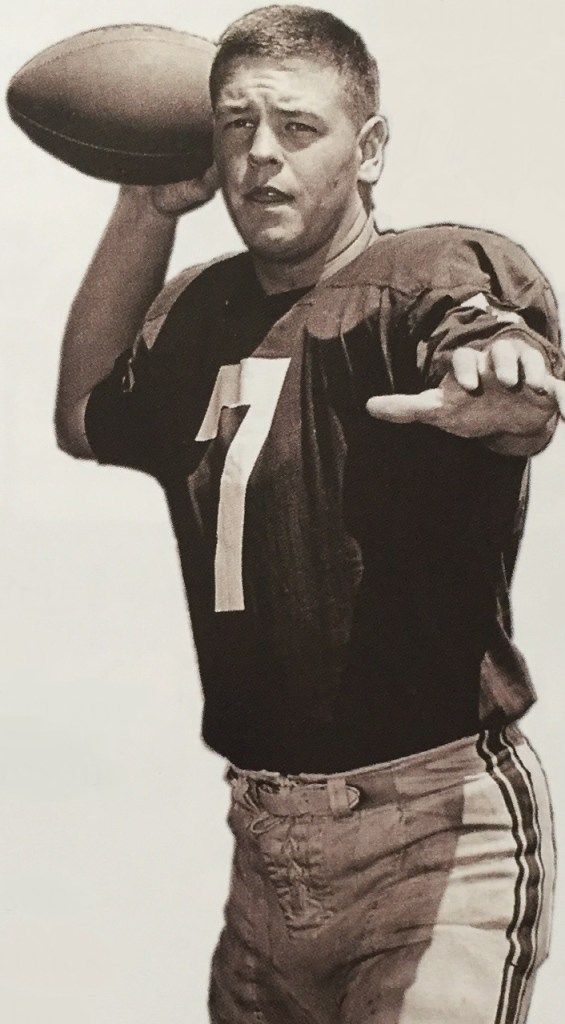
Humphrey was the first to be released, partly on his poor performance in 1965 subbing for Johnson. Then Snook, who seemingly was a lock to make the team, was surprisingly drafted into the Army.
“When Gary got called up,” Hart recalled in his book, The Jim Hart Story, “I began to see that the numbers game was working in my favor. I had realized I was potentially better than the people who were with me, but before that I didn’t think it was enough.”
Winner ultimately decided to keep the veteran Nofsinger as the backup quarterback in 1966. The young Hart cleared waivers, and was signed to the “taxi squad” roster where he would spend the first nine weeks of his rookie season.
“I needed to learn,” Hart later said, “and what better place to do it than the taxi squad? I was tickled to death to be there.”
“They were nice guys, really nice guys, all of ‘em,” Jackie Smith would later recall about the quarterback battle. “The only difference between them was that Jim Hart could throw the ball and the others couldn’t.”
WELCOME TO ST. LOUIS
With Charley Johnson at the helm, the Cards rolled to a 7-1-1 start to the 1966 season. Thoughts of an NFL championship were in the minds of, not only the fans, but players as well. But things went downhill after an injury in New York.
Johnson suffered torn knee ligaments in a game at Yankee Stadium and Terry Nofsinger took over the team. Hart was suddenly activated to the No. 2 position.
“When Nofsinger moved up,” Hart remembered, “the whole team was hot to trot. They had waited a long time for a championship and they could sense it coming. Then, we went down to Pittsburgh to play the Steelers, and they kicked the snot out of us. Things went down from there.”
The Cards lost to the Steelers 30-9 and would lose their last three of four to finish 8-5-1. Nofsinger played poorly and Jim Hart would see his first pro action in the season finale against the Browns at Busch Stadium completing 4-11 passes for 29 yards. Most of the sell out crowd may not have known who Jim Hart was on that Saturday afternoon, but that would change in 1967.
SURPRISE STARTER
Jim Hart entered his sophomore NFL season as the backup to Charley Johnson, who appeared to be fully recovered from knee surgery. Gary Snook was still in the Army and Terry Nofsinger was traded to the Atlanta Falcons. Hart had gone from an undrafted free agent to the No. 2 man on a potential championship team.
“At camp, I made up my mind to be patient and try to learn all about quarterbacking,” Hart told Sports Illustrated in 1967. “I felt that we’d get far enough in front of some teams that I’d be able to play quite a bit.”
That quote turned into the understatement of the year when Johnson was called into the Army a few weeks before the season opener. A headline in the St. Louis Post Dispatch proclaimed Hart as the No. 1 quarterback, but Hart didn’t get his hopes up.
“I thought they would trade for an experienced quarterback,” Hart told Sports Illustrated, “because I didn’t think they thought I was ready.”
The Cardinals did try to obtain a veteran quarterback. There were rumors that Earl Morrall was on their radar. However, head coach Charley Winner liked Hart. “I just told him that he was our No. 1 quarterback and that we were going to go with him all the way.”
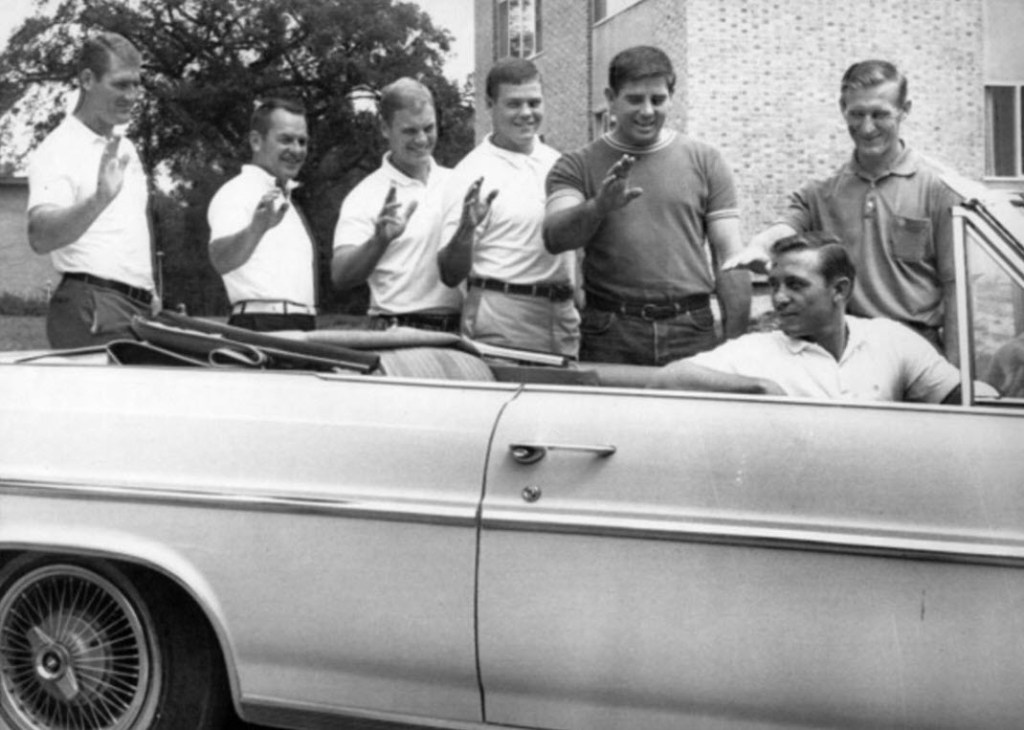
Hart threw a lot of interceptions in preseason and then threw four more in a season opening upset loss to the New York Giants. “I think we all wanted things to come too fast,” Hart later said of that game. “Maybe the purists were right. Kids can’t play quarterback.”
But Hart would lead the Cardinals to three straight victories and five wins in their next seven games. He netted his first 300-yard passing performance against Detroit and threw four touchdown passes in a blowout victory over the Eagles. Hart’s favorite receiver was rookie Dave Williams and they starred in a big nationally televised Monday night game against the NFL Champion Green Bay Packers. Hart threw for 317 yards and Williams had 147 yards and two TDs. The Cardinals blew a fourth quarter lead and lost 31-23, but Hart left his mark on the Packers.
“He has great touch,” Bart Starr said after the game. “He also has a great sense of timing and a great deal of poise.”
“You hate to give a guy an honor,” said Packers defensive lineman Henry Jordan, “but I think he’s going to be one of the great ones.”

Hart found himself on the cover of Sports Illustrated a couple of weeks later, and may have been a victim of the infamous “SI Cover Jinx” as the Cardinals lost four of their last five games. He completed his rookie season with 30 interceptions, but also passed for 3008 yards and 19 touchdowns. The Cardinals finished a disappointing 6-7-1, but overall, Jim Hart’s rookie season was deemed a success.
QUARTERBACK CONTROVERSY
Charley Johnson was still in the Army and stationed at Fort Leonard Wood, MO. He had saved up a couple of months of leave and spent two weeks in training camp and would use the remaining time for two days of weekly practice during the 1968 season. Although Hart had a successful rookie season, many veteran’s on the team preferred Johnson, who had led them to great seasons in 1963, 1964, and 1966.
Hart and Johnson were completely different quarterbacks. Hart liked to throw the bomb to Dave Williams, while Johnson would surgically take a defense a part with shorter passes and then hit them with the big play.
Winner would name Hart the starter for the season opener, but that would last only two weeks. Losses to the Rams and 49ers would send Hart to the bench. Charley Johnson started at New Orleans and led the Cardinals to a frantic comeback victory against the Saints. But Winner would bench Johnson at halftime the following week against Dallas. This would continue through the 1969 season with neither quarterback being able to grasp the starting job. The locker room was divided and there were times when Winner wouldn’t name a starting quarterback until the night before the game.
Jim Hart was able to weather the storm in 1968. He started 12 of 14 games and cut his interceptions from 30 to 18. Despite the divided locker room, and Charley Johnson looking over his shoulder, Hart led the Cardinals to a 8-1-1 record in their last ten games finishing only a half game behind the division winning Browns who they had beaten twice.
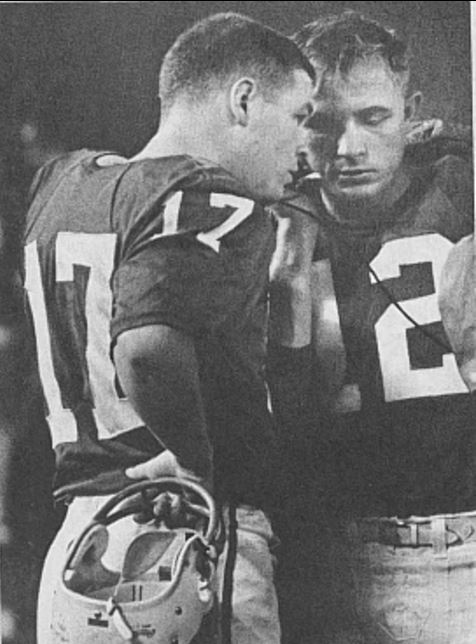
Hart was once again named starting quarterback in 1969, but a hand injury late in the preseason opened the door for Charley Johnson who had finally satisfied his commitment to the U.S. Military. Johnson would start a few weeks and then get benched for Hart. Then Hart would get benched a few weeks later.
“It was an intolerable situation,” Charley Johnson told the St. Louis Globe Democrat in 1975. “I blamed Charley Winner then and I still do. His refusal to come to grips with the problem just destroyed the team.”
“I was a Johnson man,” an anonymous veteran told the Globe Democrat in 1969. “I thought his experience gave him the edge. But, dammit, it didn’t make that much difference. It had to be one or the other, not both.”
Johnson demanded a trade at the end of the season and the Bidwill’s obliged sending him to Houston for quarterback Pete Beathard and cornerback Miller Farr.
The Cardinals were now Jim Hart’s team. He played well in 1970 as he and MacArthur Lane led the team to an 8-2-1 start including a pair of victories over the Dallas Cowboys. But then the wheels fell off. The Cards blew their post season opportunity by inexplicably losing their last three games of the season. Charley Winner was fired. The arrival of a new head coach meant Jim Hart’s career was once again in turmoil.
BOB HOLLWAY ERA
The Cardinals new coach was Bob Hollway, a defensive assistant under Bud Grant in Minnesota. In his first meeting with the media he announced “Jim Hart is No. 1 until the first day of training camp, then the job is wide open.”

Hollway would bring six quarterbacks to camp in 1971 with Hart ultimately beating out Pete Beathard. But Hart would only start nine games and was frequently booed by the home fans who demanded Beathard.
It got worse in 1972. The Cardinals traded top wide receiver John Gilliam to Minnesota for veteran quarterback Gary Cuozzo, who the Vikings had benched in 1971. It turned out to be one of the worst trades in Cardinals history.
Cuozzo, Tim Van Galder, and Hart shared time throughout another 4-9-1 season. Hart played well in his three starts and won the last two against the Rams and Eagles.
After the season finale, Hollway told Hart that “You’ll be the No. 1 next year.” The head coach wasn’t wrong, but what he didn’t know at the time was that Hart would be starting for a different head coach.
NEW LEASE ON LIFE
Exit Bob Hollway and enter Don Coryell, who ran a power house at San Diego State University. Coryell immediately proclaimed Jim Hart as the Cardinals starting quarterback and it was a decision he would not regret.
“I knew that no one quarterback was better than the others in the eyes of the other coaches,” Coryell said at the time. “But I looked at the film and knew there was no comparison in the ability of the other quarterbacks. Jim Hart could throw the football.”
“Don Coryell took a tremendous weight off my shoulders,” Hart recalled. “He just allowed me to relax. He told me that I was going to be his quarterback, and he meant it.”
In 1973, the Cardinals finished with a 4-9-1 record for the third consecutive season. But, this team was different. The offense improved from 23rd in the league to 11th. And the passing offense, led by Hart, was 5th in the league.
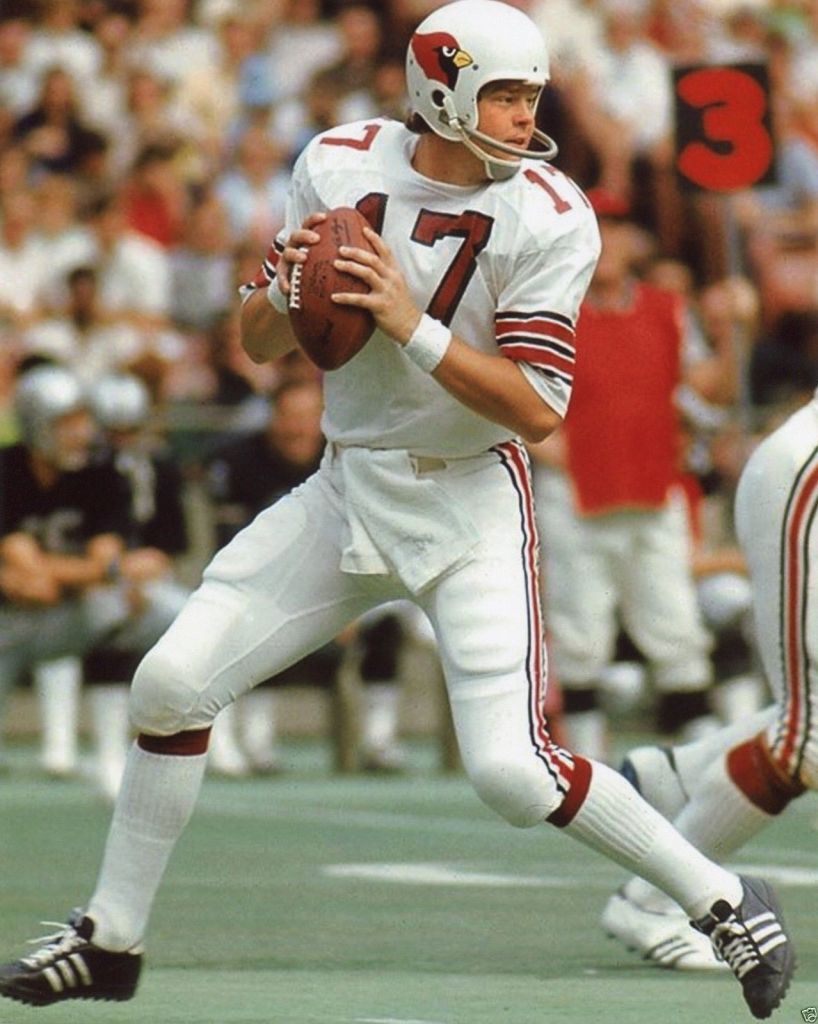
Hart excelled under Coryell’s new offense. He was named the team’s most valuable player and completed 55% of his passes, throwing for 15 touchdowns and only 10 interceptions. His new favorite target was the speedy Mel Gray. They connected for seven touchdowns, five of them greater than 40 yards.
Things were going great for Hart until a late season home game against the Lions when he was twice knocked out of the game. Hart suffered an elbow injury that almost ended his career.
“It was a very serious injury,” Coryell said. “For many months we did not know if Jim was going to be able to play again.”
“I knew the doctors were talking about surgery,” Hart said. “And I knew that I didn’t want have it. If I did, it was all over.”
Worries over Hart’s lingering elbow injury resulted in the Cardinals making another very bad trade. The team sent young fleet-footed receiver Ahmad Rashad to the Buffalo Bills for backup quarterback Dennis Shaw who played for Coryell at San Diego State.
Fans and players were shocked. How could the Big Red trade their No. 1 pick and future star for a quarterback with an 8-27 record who threw almost twice as many interceptions as touchdowns?
“At the time, explained Coryell, “we had no choice. We had to have a backup quarterback, someone with experience . . . just in case. We were very, very concerned that maybe Jimmy wouldn’t ever play again.
Thankfully, Hart elected to not have surgery and, after months of rest, he was ready for the best four years of his career.
CARDIAC CARDS
An NFL player’s strike during training camp wouldn’t stop the Cardinals in 1974. The Big Red started the season 7-0 with two big wins over the Redskins and another over the Cowboys. They went on to win the NFC East with a 10-4 record and claimed their first post season appearance in 26 years.
Although the Big Red would lose to the Vikings in the divisional playoff game, Jim Hart had a stellar season in 1974. He completed over 50% of his passes for 2411 yards, 20 TD passes and only 8 interceptions, the lowest in the NFL. He also broke Charley Johnson’s passing records of most career completions and career yardage. Hart was named NFC Player of the Year by UPI and was selected by opposing coaches to play in his first Pro Bowl.
In 1975, the Cardinals won 11 games and earned their second consecutive NFC East title. They became known as “Cardiac Cardinals” because eight of their games were decided in the final minute.
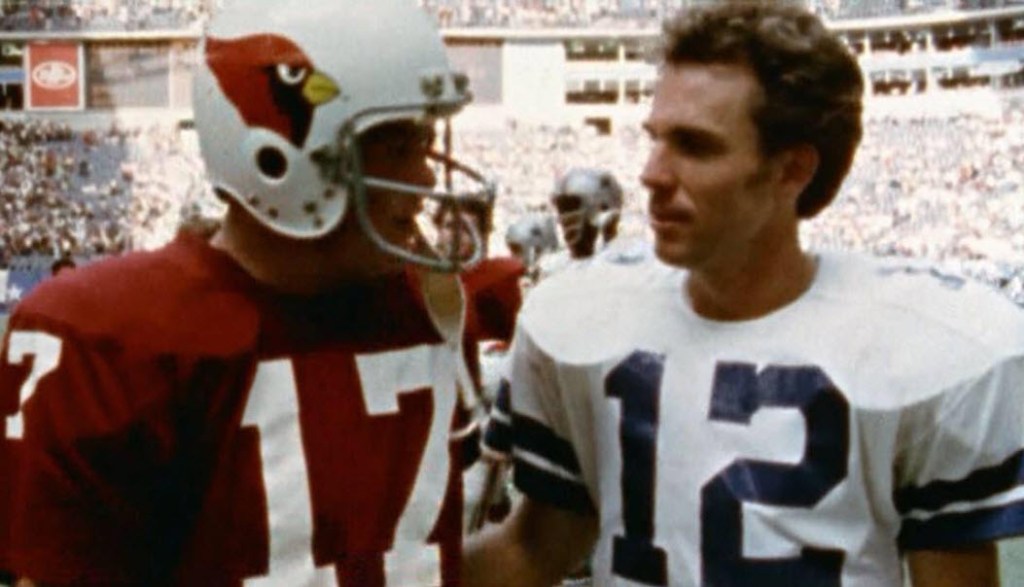
Hart had another Pro Bowl season throwing for over 2500 yards and 19 TD passes. He was sacked only eight times during season. Perhaps his most memorable touchdown came on a late November afternoon against the Washington Redskins at Busch Stadium.
Trailing 17-10, the Big Red faced a fourth down and goal with 25 seconds left in the game. Hart threw a quick pass over the middle to Mel Gray and, as Pat Summerall said, “The ball, Gray and Pat Fischer met in simultaneous rendezvous… and so did controversy.”
Redskins cornerback Pat Fischer collided with Gray just as he made the grab. The ball fell to the ground. One official signaled an incomplete pass, but Hart saw official Burt Toler signal touchdown. Hart pleaded his case as the officials huddled together.
“I just tried to bring it to the refs’ attention,” Hart told the St. Louis Post Dispatch, “that Mr. Toler called it a touchdown. But you never know if they are listening to you.”
To the dismay of the Redskins and the jubilation of the Cardinals and their fans, the officials ruled it a touchdown. The Cardinals went on to win the game in overtime, effectively eliminating the Skins from the playoffs.
Unfortunately, the Big Red’s divisional playoff game with the Los Angeles Rams did not go as well. On the Cardinals second offensive play of the game, Rams defensive end Jack Youngblood picked off a Hart pass and returned it 47 yards for a touchdown to give the Rams an early 14-0 lead. Early in the second quarter, Rams safety Bill Simpson intercepted a Hart pass over the middle and ran down the sideline for a 65 yard touchdown. The Rams 21-0 lead was too much for the Big Red to overcome. They lost 35-23.
Hart threw for 291 yards and a touchdown, but it was too little too late.

“It’s easy for me to say,” he told reporters after the game, “but we could have beat them. Take away the 14 points I gave them…” He didn’t finish his statement.
It would be Hart’s final appearance in a post season game, both losses, which undoubtedly has been the primary reason for him being snubbed from the Pro Football Hall of Fame.
In 1976 Hart threw for almost 3000 yards with 18 touchdowns and only 13 interceptions. He also became only the twentieth passer to throw for 20,000 yards in a career. It was another Pro Bowl campaign for Hart. However, the season once again ended in disappointment as the 10 win Cardinals failed to qualify for the playoffs.
In 1977 the Cardinals looked like they were headed back to the postseason. They were coming off big road wins over Minnesota and Dallas and were sitting pretty with a 7-3 record. But, the turning point of this season was upon them. A nationally televised game at Busch Stadium against Bob Griese and the Miami Dolphins.
In what became known as the “Thanksgiving Day Massacre,” the Big Red were blown out 55-14. It was a loss from which they would not recover. They would lose their last four games to finish 7-7. Coach Coryell would leave the following season and the Cardiac Cards era was over.
Hart was selected to his fourth consecutive Pro Bowl, but his season didn’t quite live up to the previous three. He passed for over 2500 yards, but threw only 13 TD passes and 18 interceptions. The Cards all-time leading passer would soon be playing for yet another new head coach.
BOOMER SOONER
1978 saw the departure of head coach Don Coryell, the trade of Conrad Dobler, the retirement of Jackie Smith, and the season ending leg injury to budding star J.V. Cain.
It also marked the surprise hiring of legendary Bud Wilkinson as the new Big Red head coach. Wilkinson led Oklahoma to three National Championships, but hadn’t coached at any level in 15 years.
“When I first heard it, I thought it was a joke.” Jim Hart told the St. Louis Post Dispatch. Now that I know it’s for real, I’m kind of happy. It’s neat. It’s like meeting a legend. But it was a big surprise.”
Kicker Jim Bakken joked, “Wilkerson? He’s a radio announcer, isn’t he?”
The Cardinals struggled under Wilkinson in 1978 as they lost their first eight games of the season. But Jim had a solid campaign throwing the ball, setting career highs in completions (240), attempts (477) and passing yards (3121). The Big Red won six of their last eight games including upset wins against the Redskins and Falcons.

Wilkinson didn’t make it through the following season as he was fired for refusing to bench Hart. The Big Red were 3-10 and Bill Bidwill wanted to take a look at former top pick Steve Pisarkiewicz. Larry Wilson took over the team and Hart went from starter to the scout team quarterback.
“Yeah, it’s a change,” he told the Post Dispatch. “It’s a little hard to adjust to. But I’m doing it.”
Jim Hart was 36 years old when the 1980 season began and he was playing for his fifth head coach in the last eleven years. The Cardinals brought back their former offensive line coach Jim Hanifan to lead the team. Hanifan said he was looking forward to coaching a “damn fine quarterback (Jim Hart).”
The Cardinals won only five games in 1980 and Jim passed for almost 3000 yards with 16 touchdowns and 20 interceptions. The highlight of his season came in Detroit when the veteran QB became only the seventh player in NFL history to throw for more than 30,000 yards in a career. But all he would talk about after the game were the missed opportunities in the 20-7 loss.
1980 would also be the final season that James Warren Hart would be the full time starting back for the Cardinals. The Big Red would draft his future replacement in 1981.
END OF AN ERA
Neil Lomax practically set every college passing record while at Portland State University. The Cardinals were stunned when he was still available and they selected him with the 33rd pick in the draft.
Many felt that Hart would play one more season and then hand over the keys to Lomax. It didn’t quite work out that way. Hart struggled with an injury early in the season and was benched after a 52-10 loss to the Eagles. The Cardinals were 3-6 when Lomax was named the starter for the final six games of the season. He immediately led the team to four straight victories to put them in playoff contention. It was evident Lomax’s time had come.
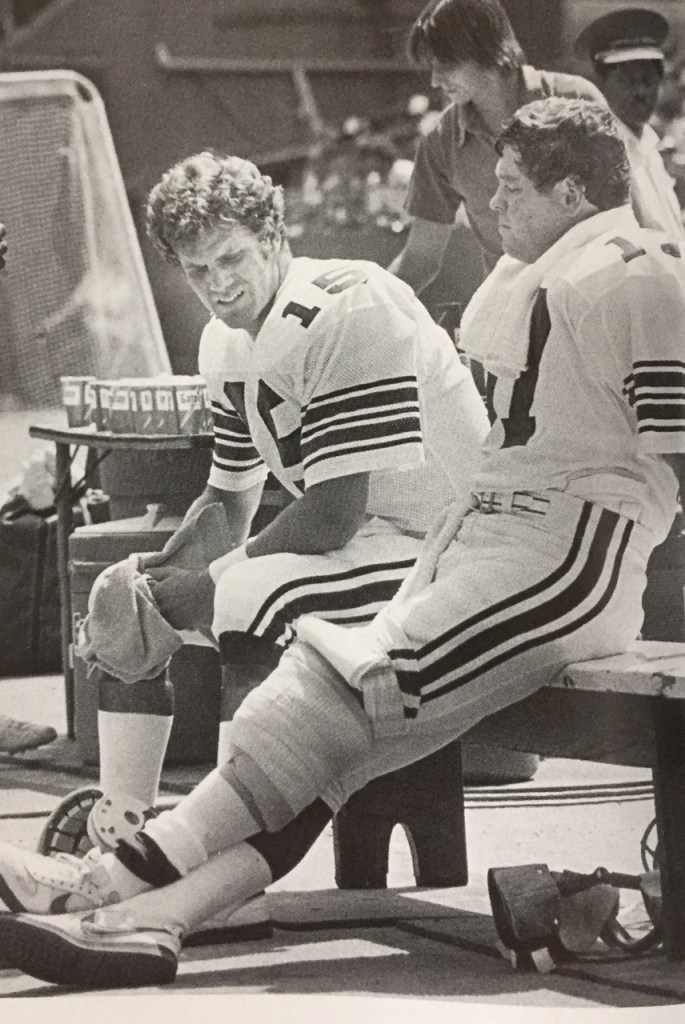
Hart would return as a backup to Lomax in 1982 and 1983. He appeared in only 4 games in ’82, but did lead the Cardinals to a 10-7 win over Chicago after relieving a struggling Lomax. He also started three games early in the 1983 season after Lomax suffered a shoulder injury in the season opener in New Orleans.
Hart’s highlight of 1983 came at Veteran’s Stadium when he led the Big Red to a come from behind 14-11 upset of the Eagles. Hart threw his last TD pass of his career when he connected with Roy Green with just seconds left in the game.
“That was a sweet moment in my young life,” beleaguered head coach Jim Hanifan said after the game.
“Oh yeah, it feels good,” a grinning Hart said after the win.
Lomax returned to action a couple of weeks later, and Jim Hart’s Big Red career was over.
The Cardinals reportedly wanted to celebrate Hart’s career with a farewell send-off in the season finale against the Eagles. He could have rode off into the sunset (or snow storm) with his longtime teammate and friend Dan Dierdorf. But, Hart did not want to retire and the Cardinals released the 18 year veteran a few weeks after the end of the season.
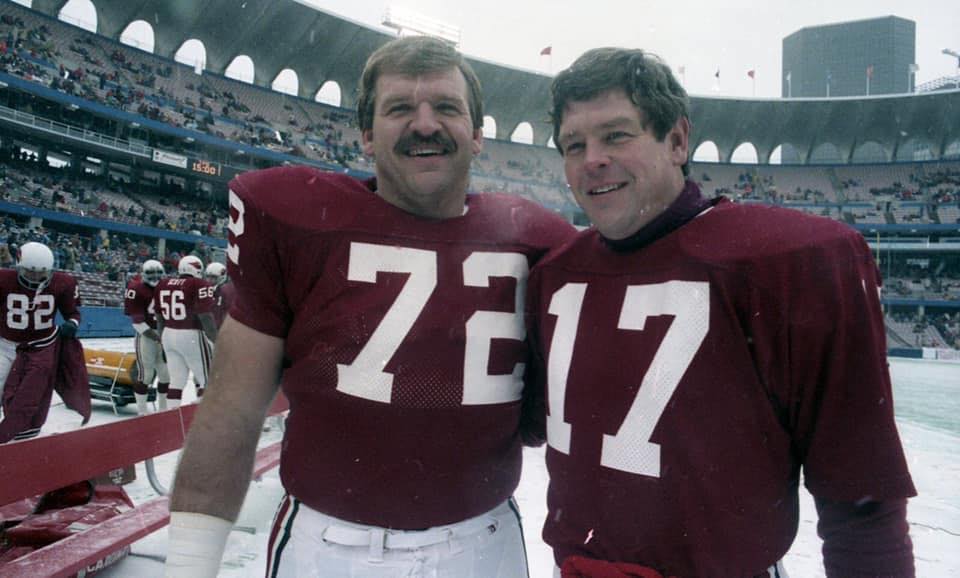
“After all those years, the way it happened, it left a bitter taste in my mouth,” Hart told the St. Louis Post Dispatch after his release in 1984. “But I had seen better players than I treated the same way. It was not surprising.”
Hart signed a contract with the Washington Redskins a couple of months after his release.
“If I didn’t play a down and could be sitting here next year wearing a Super Bowl ring,” Hart said, “I would be a happy man.”
James Warren Hart didn’t get that elusive Super Bowl ring with the Redskins in 1984. He would retire at season’s end with the third most passing yards and tenth most touchdown passes in NFL history. Many thought he was a lock for the Hall of Fame, but the relaxation of pass defense rules in the mid-80s turned the NFL into a passing league. Players like Jay Cutler and Matt Ryan have surpassed Hart’s career numbers and the chances of him getting into the Hall of Fame are now very slim.
Hart played in 199 games in 18 seasons for the Cardinals and is still the franchise leader in almost all career passing categories including completions (2590), attempts (5069), yardage (34,639), touchdowns (209), interceptions (247), 4th quarter comebacks (20), and game winning drives (23).
After being unceremoniously released in 1984, Hart was finally enshrined into the Cardinals Ring of Honor in 2017. It was a long time coming, and the Cardinals still have work to do to celebrate some of the former St. Louis stars from the past.
Jim Hart has always been a fan favorite in St. Louis. He made his home here, ran a business here, and continues to hold a special place in fans hearts. Below are some of his former teammate’s memories of #17.
“When I think of Jim Hart, the first word that comes to mind is class. Class personified.” – Roy Green
“He was our rudder because we had a tendency to go a little bit off course. Jim was the stabilizing leader of that group. By God somebody had to be sane, and thankfully it was Jim.” – Dan Dierdorf
“If it came down to the end of the game in the fourth quarter and you needed a drive, we knew he was the guy who was going to do it for us.” – Roger Wehrli
“I always admired Jim. He never once put the blame for a missed pass on anybody. He never pointed a finger. A lot of quarterbacks will blame receivers of the offensive line, but Jim never did that.” – Pat Tilley
“The thing that always impressed me about him was that even though he wasn’t perceived as a tough guy, he played hurt and he played well hurt.” – Larry Stallings
“A perfect example of what an NFL quarterback should be.” – former Big Red trainer Jim Omohundro
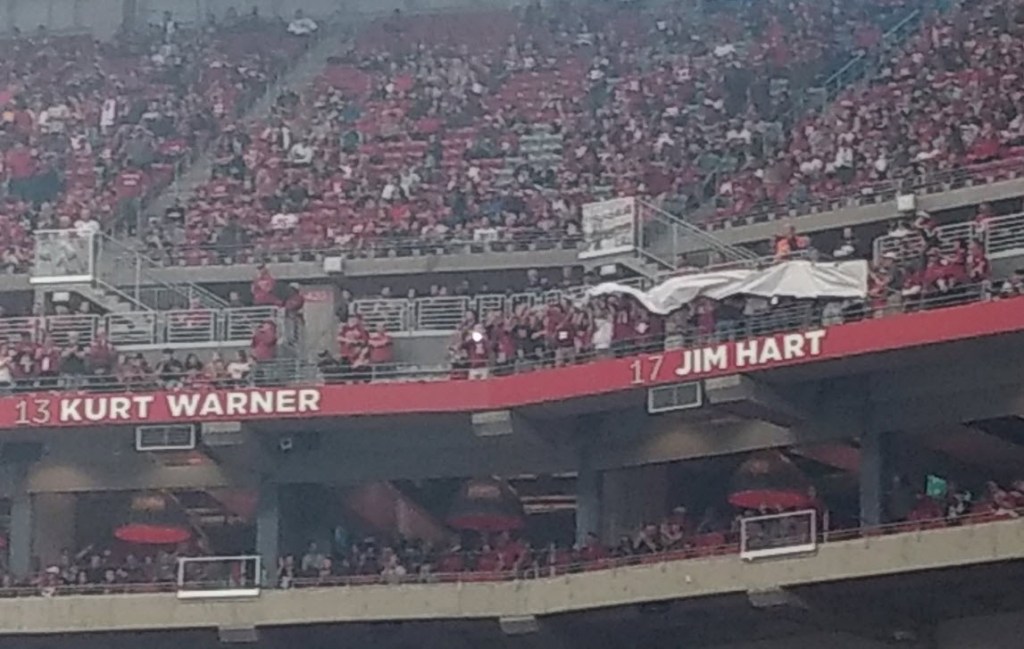


Excellent work! Jim Hart was our QB… a St. Louis icon!
LikeLiked by 1 person
Nice article. Appreciate y’all remembering. Except for the recollection (erroneously) of the ESFL Denver comment. That never happened! FYI …
LikeLiked by 1 person
Thanks for setting me straight on the Denver Gold story! Hope you’re doing well and look forward to seeing you at the next Sunnyhill tournament!
LikeLike
GREAT story, as usual, Bob. Reading it actually made me sad. What a bunch of stupid mistakes!!! If they had let him learn the system from the sidelines, then just plugged him in behind Banks, imagine how different those years could have been!!! I am so happy and proud that he is in the Ring of Honor in AZ, but he should be in the Hall of Fame!
I sure do admire your passion and skills! And once again, thank you for the copious quantity of hours and time you spend feeding the appetites of our FB group members!!! Lori G
On Wed, Apr 29, 2020 at 12:04 PM THE BIG RED ZONE wrote:
> Bob Underwood posted: ” From undrafted free agent to one of the most > prolific passers in NFL history, Jim Hart’s career had more than its fair > share of challenges. The Chicago area native had to overcome fan favorite > Charley Johnson in the late 60s, the Bob Hollway era in the e” >
LikeLiked by 1 person
I appreciate the comments Lori! And thanks for our contributions to the group as well. We have all learned a great deal from you over the last year or so!
LikeLike
That’s a great article about Jim Hart. I grew up watching the Cardinals and was a fan of his when I was in college also in the late 1970s and early 1980s. A win over the Cowboys in 1981 was a highlight. I watched it on TV in college with a friend who also hated the Cowboys.
Didn’t he set some record for consecutive completions against the Atlanta Falcons in 1980 or 1981? The Cardinals’ bad defense usually figured out a way to squander early leads by the team with second half collapses.
LikeLiked by 1 person
Wow, this was a bitter sweet read. Sweet because when Ibtell you I loved Jim Hart , I meant it. He was man ten grand. I lived and died every play with him . Reading this took me right back to Hank Stram and Jack Buck even Ron Jacober days of listening to the Big Red on the radio and yes tv. The cardiac cards gave life and death in one afternoon. The Metcalf great runs and the Metcalf heartbreaking fumbles. Pat Tolley amazing catches and Ike Harris, J. V cain , Jackie Smith , Jim Otis omg Imloved those guys Ibwanted wins for them so bad Ibwoild cry after lisses as a kid the broke my heart so many times but Ibwould never give up on them. Great read #Harthalloffame2020
LikeLiked by 1 person
Sorry for the many typos I was so excited I did mot proof read…lol
LikeLiked by 1 person
So true on the Terry Metcalfe fumbles. But is son Eric Metcalfe helped the Cardinals make the 1998 playoffs!
LikeLike
Sorry for the many typos I was so excited I did not proof read…lol
LikeLiked by 1 person
Very nice article on Hart. In a more stable organization, he would have received more recognition and would be in the HOF. My father had season tickets so I have a lot of nice memories. One of the most entertaining games was in1976 here against the Cowboy. Metcalf had about a 68 yr. TD run. Rookie Tony Dorsett had a 77 yard smooth TD. Hart threw a beautiful high arching bomb for 60 plus yards which Mel Gray adjusted to, craddled into his arms on his left side and sprinted into the end zone. We lost but it was a great game. A lot of great memories despite some organizational problems and poor drafts In the late 70s…79 was good draft. The Senior Committee for the HOF should seriously push for Hart and Roy Green.
LikeLike
Pingback: The 10 Greatest Big Red Games from the 1980s | THE BIG RED ZONE